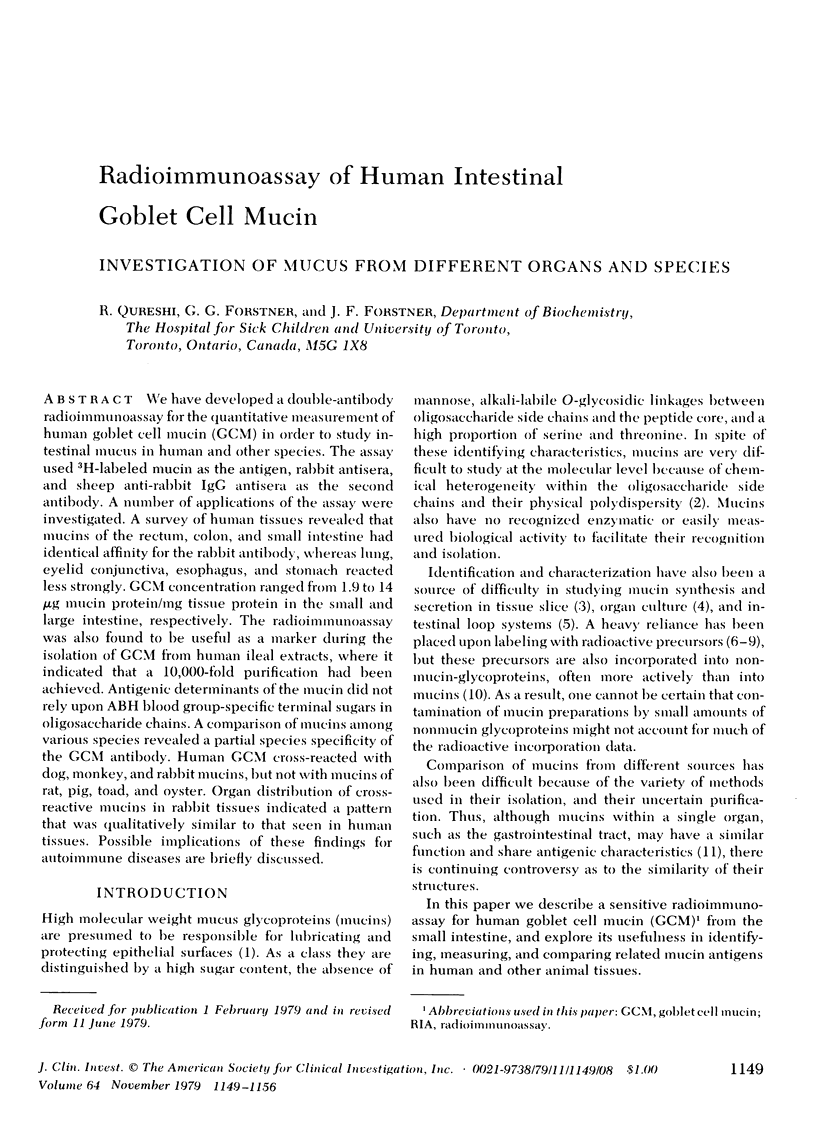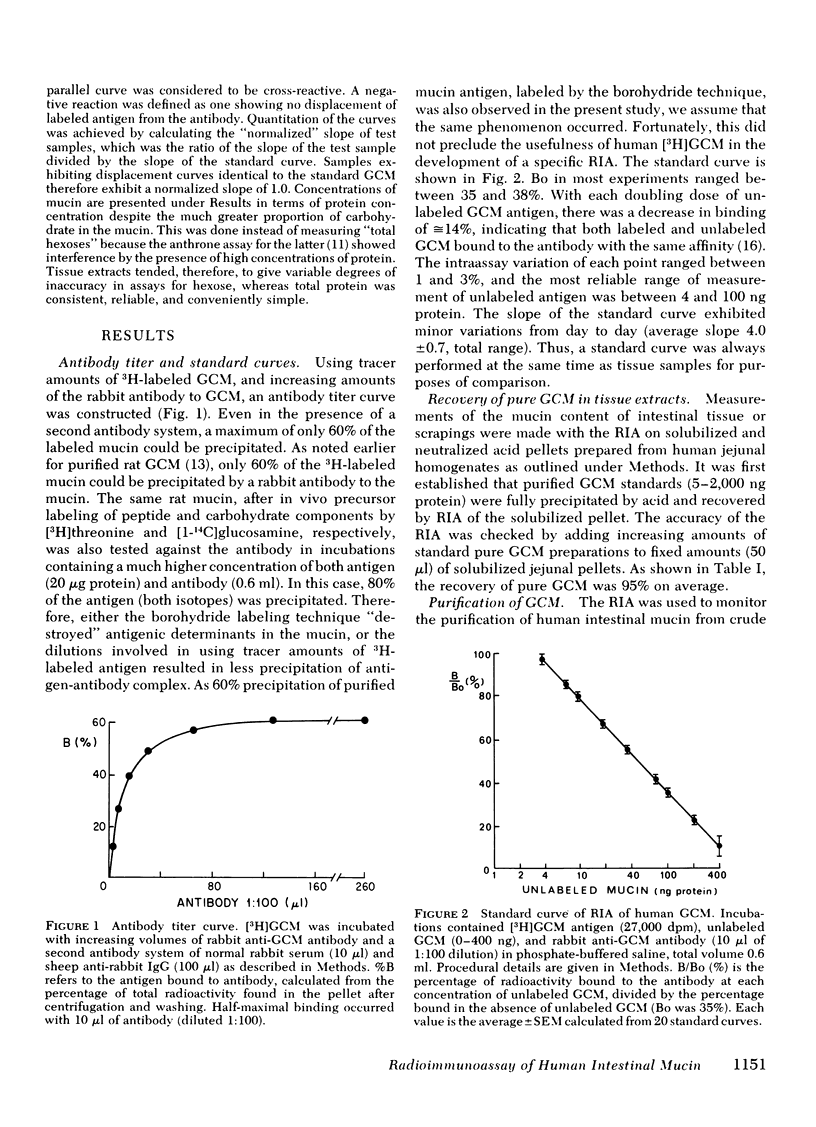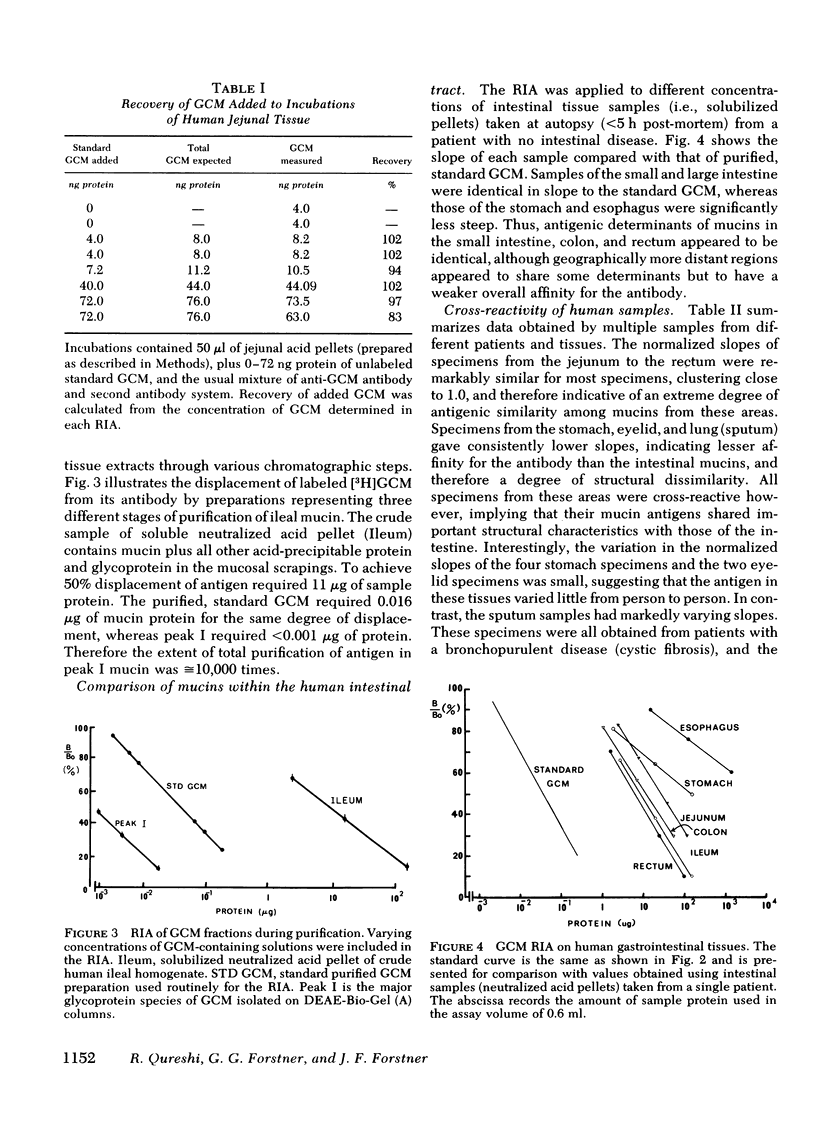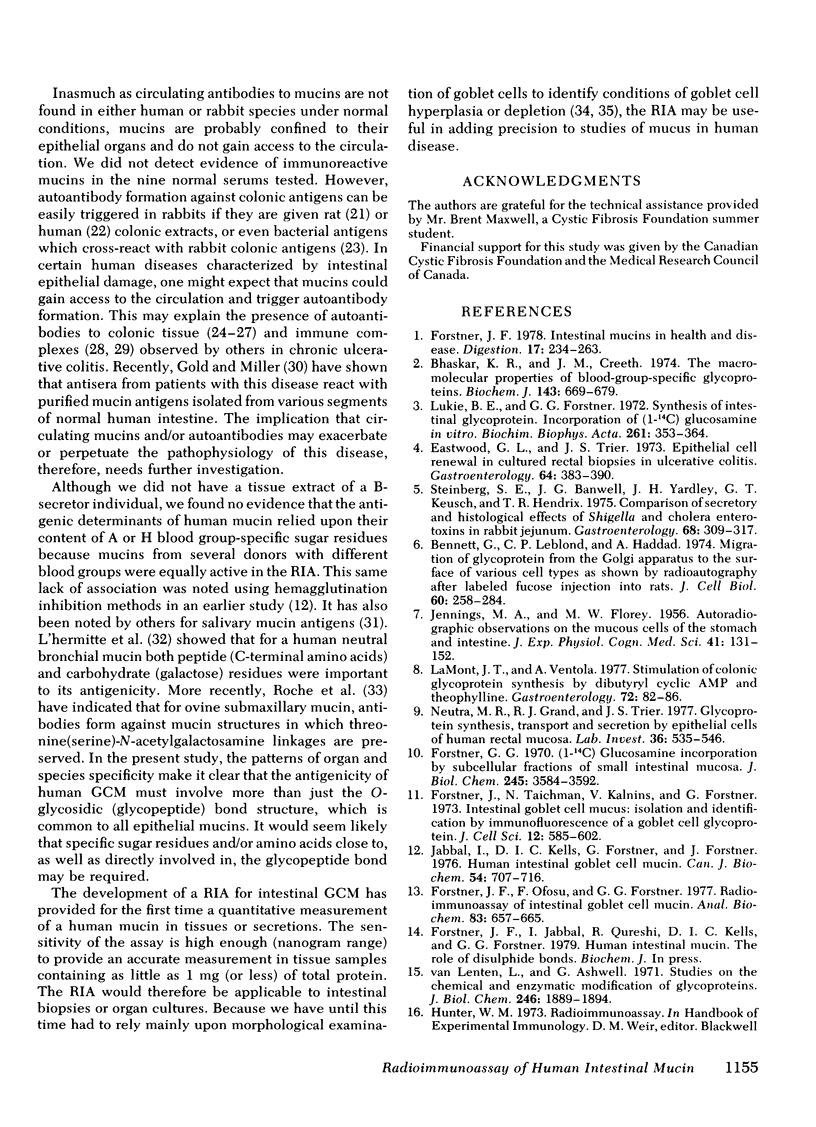Abstract
We have developed a double-antibody radioimmunoassay for the quantitative measurement of human goblet cell mucin (GCM) in order to study intestinal mucus in human and other species. The assay used 3H-labeled mucin as the antigen, rabbit antisera, and sheep anti-rabbit IgG antisera as the second antibody. A number of applications of the assay were investigated. A survey of human tissues revealed that mucins of the rectum, colon, and small intestine had identical affinity for the rabbit antibody, whereas lung eyelid conjunctiva, esophagus, and stomach reacted less strongly. GCM concentration ranged from 1.9 to 14 microgram mucin protein/mg tissue protein in the small and large intestine, respectively. The radioimmunoassay was also found to be useful as a marker during the isolation of GCM from human ileal extracts, where it indicated that a 10,000-fold purification had been achieved. Antigenic determinants of the mucin did not rely upon ABH blood group-specific terminal sugars in oligosaccharide chains. A comparison of mucins among various species revealed a partial species specificity of the GCM antibody. Human GCM cross-reacted with dog, monkey, and rabbit mucins, but not with mucins of rat, pig, toad, and oyster. Organ distributions of cross-reactive mucins in rabbit tissues indicated a pattern that was qualitatively similar to that seen in human tissues. Possible implications of these findings for autoimmune diseases are briefly discussed.
Full text
PDF







Selected References
These references are in PubMed. This may not be the complete list of references from this article.
- Asherson G. L., Holborow E. J. Autoantibody production in rabbits. VII. Autoantibodies to gut produced by the injection of bacteria. Immunology. 1966 Feb;10(2):161–167. [PMC free article] [PubMed] [Google Scholar]
- Bennett G., Leblond C. P., Haddad A. Migration of glycoprotein from the Golgi apparatus to the surface of various cell types as shown by radioautography after labelled fucose injection into rats. J Cell Biol. 1974 Jan;60(1):258–284. doi: 10.1083/jcb.60.1.258. [DOI] [PMC free article] [PubMed] [Google Scholar]
- Bhaskar K. R., Creeth J. M. The macromolecular properties of blood-group-specific glycoproteins. Characterization of a series of fractions obtained by density-gradient ultracentrifugation. Biochem J. 1974 Dec;143(3):669–679. doi: 10.1042/bj1430669. [DOI] [PMC free article] [PubMed] [Google Scholar]
- Carlsson H. E., Lagercrantz R., Perlmann P. Immunological studies in ulcerative colitis. VIII. Antibodies to colon antigen in patients with ulcerative colitis, Crohn's disease, and other diseases. Scand J Gastroenterol. 1977;12(6):707–714. doi: 10.3109/00365527709181708. [DOI] [PubMed] [Google Scholar]
- Davis S. S., Scobie S., Inglis A. The effect of sulphydryl compounds and cross linking agents on the viscous and viscoelastic properties of mucus. Biorheology. 1975 Jun;12(3-4):225–232. doi: 10.3233/bir-1975-123-415. [DOI] [PubMed] [Google Scholar]
- Eastwood G. L., Trier J. S. Epithelial cell renewal in cultured rectal biopsies in ulcerative colitis. Gastroenterology. 1973 Mar;64(3):383–390. [PubMed] [Google Scholar]
- Forstner G. G. (1-14C)glucosamine incorporation by subcellular fractions of small intestinal mucosa. Identification by precursor labeling of three functionally distinct glycoprotein classes. J Biol Chem. 1970 Jul 25;245(14):3584–3592. [PubMed] [Google Scholar]
- Forstner J. F. Intestinal mucins in health and disease. Digestion. 1978;17(3):234–263. doi: 10.1159/000198115. [DOI] [PubMed] [Google Scholar]
- Forstner J. F., Ofosu F., Forstner G. G. Radioimmunoassay of intestinal goblet cell mucin. Anal Biochem. 1977 Dec;83(2):657–665. doi: 10.1016/0003-2697(77)90070-7. [DOI] [PubMed] [Google Scholar]
- Forstner J., Taichman N., Kalnins V., Forstner G. Intestinal goblet cell mucus: isolation and identification by immunofluorescence of a goblet cell glycoprotein. J Cell Sci. 1973 Mar;12(2):585–602. doi: 10.1242/jcs.12.2.585. [DOI] [PubMed] [Google Scholar]
- Gold D. V., Miller F. A mucoprotein with colon-specific determinants. Tissue Antigens. 1978 Apr;11(4):362–371. doi: 10.1111/j.1399-0039.1978.tb01269.x. [DOI] [PubMed] [Google Scholar]
- Gold D. V., Miller F. Characterization of human colonic mucoprotein antigen. Immunochemistry. 1974 Jul;11(7):369–375. doi: 10.1016/0019-2791(74)90190-6. [DOI] [PubMed] [Google Scholar]
- HOLBOROW E. J., ASHERSON G. L., WIGLEY R. D. AUTOANTIBODY PRODUCTION IN RABBITS. VI. THE PRODUCTION OF AUTOANTIBODIES AGAINST RABBIT GASTRIC, ILEAL AND COLONIC MUCOSA. Immunology. 1963 Nov;6:551–560. [PMC free article] [PubMed] [Google Scholar]
- Hammarström S., Lagercrantz R., Perlmann P., Gustafsson B. E. Immunological studies in ulcerative colitis. II. "Colon" antigen and human blood group A- and H-like antigens in germfree rats. J Exp Med. 1965 Dec 1;122(6):1075–1085. doi: 10.1084/jem.122.6.1075. [DOI] [PMC free article] [PubMed] [Google Scholar]
- JENNINGS M. A., FLOREY H. W. Autoradiographic observations on the mucous cells of the stomach and intestine. Q J Exp Physiol Cogn Med Sci. 1956 Apr;41(2):131–152. doi: 10.1113/expphysiol.1956.sp001171. [DOI] [PubMed] [Google Scholar]
- Jabbal I., Kells D. I., Forstner G., Forstner J. Human intestinal goblet cell mucin. Can J Biochem. 1976 Aug;54(8):707–716. doi: 10.1139/o76-102. [DOI] [PubMed] [Google Scholar]
- LaMont J. T., Ventola A. Stimulation of colonic glycoprotein synthesis by dibutyryl cyclic AMP and theophylline. Gastroenterology. 1977 Jan;72(1):82–86. [PubMed] [Google Scholar]
- Lhermitte M., Lambin G., Lafitte J. J., Rousseau J., Degand P., Roussel P. Properties of human neutral bronchial mucins after modification of the peptide or the carbohydrate moieties. Biochimie. 1976;58(3):367–372. doi: 10.1016/s0300-9084(76)80444-0. [DOI] [PubMed] [Google Scholar]
- Lukie B. E., Forstner G. G. Synthesis of intestinal glycoprotein. Incorporation of (I- 14 C) glucosamine in vitro. Biochim Biophys Acta. 1971 Feb 28;261(2):353–364. [PubMed] [Google Scholar]
- Marshall T., Allen A. The isolation of a high-molecular-weight glycoprotein from pig colonic mucus. Biochem Soc Trans. 1977;5(2):436–439. doi: 10.1042/bst0050436. [DOI] [PubMed] [Google Scholar]
- NAIRN R. C., FOTHERGILL J. E., McENTEGART M. G., PORTEOUS I. B. Gastro-intestinal-specific antigen: an immunohistological and serological study. Br Med J. 1962 Jun 30;1(5295):1788–1790. doi: 10.1136/bmj.1.5295.1788. [DOI] [PMC free article] [PubMed] [Google Scholar]
- Neutra M. R., Grand R. J., Trier J. S. Glycoprotein synthesis, transport, and secretion by epithelial cells of human rectal mucosa: normal and cystic fibrosis. Lab Invest. 1977 May;36(5):535–546. [PubMed] [Google Scholar]
- Nielsen H., Binder V., Daugharty H., Svehag S. E. Circulating immune complexes in ulcerative colitis. I. Correlation to disease activity. Clin Exp Immunol. 1978 Jan;31(1):72–80. [PMC free article] [PubMed] [Google Scholar]
- Nielsen H., Petersen P. H., Svehag S. E. Circulating immune complexes in ulcerative colitis.--II. Correlation with serum protein concentrations and complement conversion products. Clin Exp Immunol. 1978 Jan;31(1):81–91. [PMC free article] [PubMed] [Google Scholar]
- Oemrawsingh I., Roukema P. A. Immunological characterization and detection of human submandibular mucins in saliva, dental plaque and submandibular glands. Arch Oral Biol. 1976;21(12):755–759. doi: 10.1016/0003-9969(76)90066-2. [DOI] [PubMed] [Google Scholar]
- Roche J. K., Day E. D., Hill H. D. Rabbit antibodies to ovine-submaxillary mucin. Detection, specificity and cross-reactivity. Immunochemistry. 1978 May;15(5):339–343. doi: 10.1016/0161-5890(78)90096-2. [DOI] [PubMed] [Google Scholar]
- SHEFFNER A. L. The reduction in vitro in viscosity of mucoprotein solutions by a new mucolytic agent, N-acetyl-L-cysteine. Ann N Y Acad Sci. 1963 Mar 30;106:298–310. doi: 10.1111/j.1749-6632.1963.tb16647.x. [DOI] [PubMed] [Google Scholar]
- Steinberg S. E., Banwell J. G., Yardley J. H., Keusch G. T., Hendrix T. R. Comparison of secretory and histological effects of shigella and cholera enterotoxins in rabbit jejunum. Gastroenterology. 1975 Feb;68(2):309–317. [PubMed] [Google Scholar]
- Sturgess J., Reid L. An organ culture study of the effect of drugs on the secretory activity of the human bronchial submucosal gland. Clin Sci. 1972 Oct;43(4):533–543. doi: 10.1042/cs0430533. [DOI] [PubMed] [Google Scholar]
- Van Lenten L., Ashwell G. Studies on the chemical and enzymatic modification of glycoproteins. A general method for the tritiation of sialic acid-containing glycoproteins. J Biol Chem. 1971 Mar 25;246(6):1889–1894. [PubMed] [Google Scholar]
- Yardley J. H., Bayless T. M., Luebbers E. H., Halsted C. H., Hendrix T. R. Goblet cell mucus in the small intestine. Findings after net fluid production due to cholera toxin and hypertonic solutions. Johns Hopkins Med J. 1972 Jul;131(1):1–10. [PubMed] [Google Scholar]


